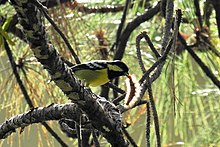| Elegant tit | |
|---|---|

| |
| Male ssp elegans | |
| Conservation status | |
 Least Concern (IUCN 3.1) | |
| Scientific classification | |
| Domain: | Eukaryota |
| Kingdom: | Animalia |
| Phylum: | Chordata |
| Class: | Aves |
| Order: | Passeriformes |
| Family: | Paridae |
| Genus: | Pardaliparus |
| Species: | P. elegans |
| Binomial name | |
| Pardaliparus elegans (Lesson, 1831) | |

| |
| Range of Periparus in The Philippines | |
| Synonyms | |
|
Parus elegans | |
The elegant tit (Pardaliparus elegans) is a species of bird in the tit family Paridae endemic to the Philippines.
Description and taxonomy

Small, sexes similar, with 9 races differing by shading and the amount and location of the white or yellow spotting in the wings and black; male top of head, throat, and upper breast glossy blue black; nape black with yellow spot; mantle black with white spots; lower back yellowish grey; tail black feathers edged white on basal 1/2 and second; primaries edged white; face, lower breast, and belly yellow. female is duller. imm resembles ad; has yellowish throat and blackish moustachial streaks. Bill black sometimes with gray at base in ad, yellowish to yellow orange with top and bottom horn in inn; eye dark brown; legs gray.
The species was formerly included in the much larger genus Parus but was moved to Pardaliparus with the yellow-bellied tit and the Palawan tit when Parus was split into several resurrected genera following the publication of a detailed molecular phylogenetic analysis in 2013.
Subspecies
Nine subspecies are recognized:
- P. e. elegans – Most of Luzon (except Northwest and Bataan), Mindoro. Catanduanes and Panay
- P. e. edithae – Calayan Island and Camiguin Norte
- P. e. montigenus – Northwest Luzon
- P. e. gilliardi – Bataan Peninsula
- P. e. albescens – Ticao Island, Masbate, Guimaras and Negros
- P. e. visayanus – Cebu
- P. e. mindananesis - Samar, Leyte and Mindanao
- P. e. suluensis – Sulu Archipelago except Bongao Island
- P. e. bongaoensis- Bongao Island –
Diet is not well known but includes insects, seeds and fruit. Usually seen in pairs of small groups and mixed-species flocks other birds such as white-eyes, sunbirds, sulphur-billed nuthatches, leaf warblers and flowerpeckers.
Habitat and conservation

It is endemic to the Philippines, ranging across most of the islands. Its natural habitats are tropical moist lowland forest and tropical moist montane forest as high as 2,480 meters above sea level.
It is assessed as a Least-concern species by the International Union for Conservation of Nature as it is fairly common in its range and tolerant of disturbed habitat.
References
- BirdLife International (2016). "Pardaliparus elegans". IUCN Red List of Threatened Species. 2016: e.T22711800A94308825. doi:10.2305/IUCN.UK.2016-3.RLTS.T22711800A94308825.en. Retrieved 17 November 2021.
- Johansson, U.S.; Ekman, J.; Bowie, R.C.K.; Halvarsson, P.; Ohlson, J.I.; Price, T.D.; Ericson, P.G.P. (2013). "A complete multilocus species phylogeny of the tits and chickadees (Aves: Paridae)". Molecular Phylogenetics and Evolution. 69 (3): 852–860. doi:10.1016/j.ympev.2013.06.019. PMID 23831453.
- Gill, Frank; Donsker, David (eds.). "Waxwings and their allies, tits & penduline tits". World Bird List Version 6.1. International Ornithologists' Union. Retrieved 15 February 2016.
- Gosler, Andrew; Clement, Peter (2020). "Elegant Tit (Periparus elegans), version 1.0". Birds of the World. doi:10.2173/bow.eletit2.01. ISSN 2771-3105.
- BirdLife International 2004. Parus elegans. 2006 IUCN Red List of Threatened Species. Downloaded on 26 July 2007.
- Gosler, A. & P. Clement (2007) "Family Paridae (Tits and Chickadees)" pp. 662–709. in del Hoyo, J.; Elliot, A. & Christie D. (editors). (2007). Handbook of the Birds of the World. Volume 12: Picathartes to Tits and Chickadees. Lynx Editions. ISBN 978-84-96553-42-2
- A Guide to the Birds of the Philippines (2000). Robert S. Kennedy, Pedro C. Gonzales, Edward C. Dickinson, Hector C. Miranda Jr., and Timothy H. Fisher
| Taxon identifiers | |
|---|---|
| Periparus elegans | |
| Parus elegans | |